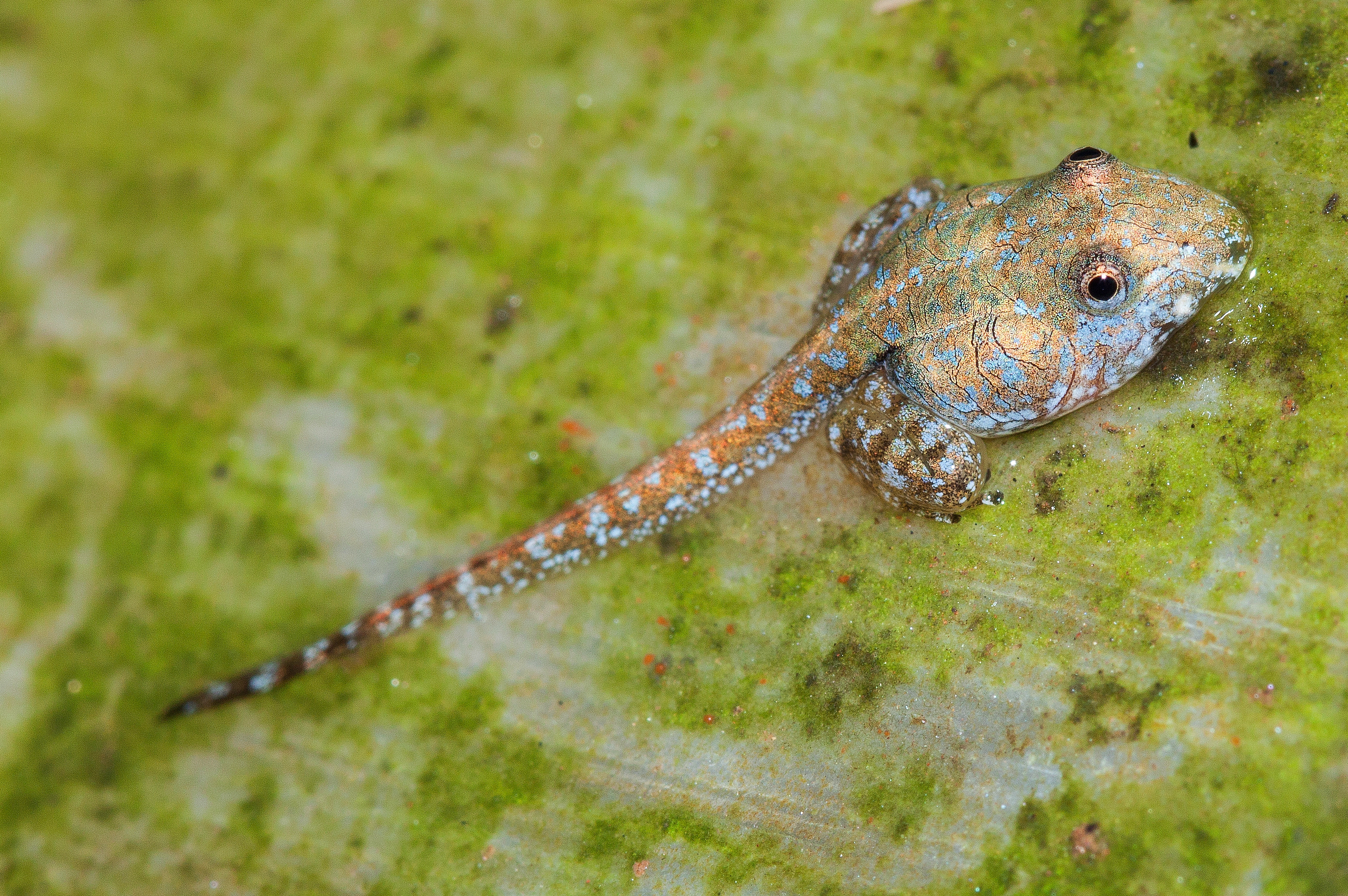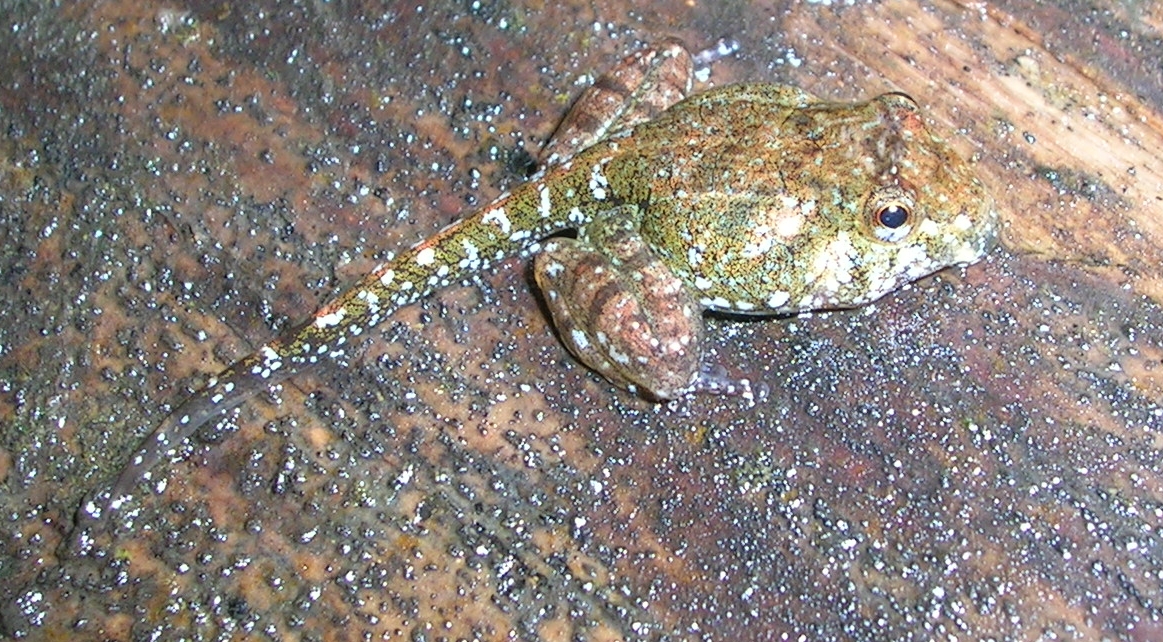Indirana Semipalmata on:
[Wikipedia]
[Google]
[Amazon]
''Indirana semipalmata'' is a species of frog endemic to the Western Ghats region of southern India. They are small frogs, reaching lengths of about from snout to vent. The species breeds during the monsoons, laying their eggs on moist rocks and tree bark. Their tadpoles are terrestrial - hatching, feeding, and undergoing


 The ecology and biology of ''Indirana semipalmata'' has not been extensively studied. It is a terrestrial species generally found on vegetation beside the banks of streams and rivers ( riparian habitats). It can also be found in
The ecology and biology of ''Indirana semipalmata'' has not been extensively studied. It is a terrestrial species generally found on vegetation beside the banks of streams and rivers ( riparian habitats). It can also be found in
Indirana semipalmata
'. In: IUCN 2011. IUCN Red List of Threatened Species. Version 2011.2.
metamorphosis
Metamorphosis is a biological process by which an animal physically develops including birth or hatching, involving a conspicuous and relatively abrupt change in the animal's body structure through cell growth and differentiation. Some inse ...
without ever entering any standing bodies of water.
Description
''Indirana semipalmata'' is a small frog, with a snout-vent length (SVL) of . The snout is blunt with moderate canthal ridges. The space between the eyes is about the same width as each of the upper eyelids. The tympanum and the eyes are of the same diameter. It possesses vomerine teeth with two slightly oblique oval groups just behind the level of the rear edge of the choanae. The males of the species lack vocal sacs. The first fingers of the forelimbs extend slightly beyond the second. At the ventral surface of each joint are well-developed tubercles and there is a single oval tubercle along the inner metatarsals. If the hind limbs are stretched forward the length of the body, the tibiotarsal ("ankle") articulation reaches the snout. The skin of ''Indirana semipalmata'' has short longitudinal glandular folds on the back; while on the bottom surface, it is smooth . It is predominantly brown in coloration with the throat and chest mottled and lighter in color. The temples and the sides of the eyes (the temporal and loreal regions) are black. A dark band is also present between the eyes at the top of the head. The limbs possess dark stripes across.Taxonomy
''Indirana semipalmata'' was first described by the Belgian-British zoologistGeorge Albert Boulenger
George Albert Boulenger (19 October 1858 – 23 November 1937) was a Belgian-British zoologist who described and gave scientific names to over 2,000 new animal species, chiefly fish, reptiles, and amphibians. Boulenger was also an active botani ...
in 1882 as ''Rana semipalmata''. The exact location the type specimen was collected from is unknown, but it was recorded as "Malabar
Malabar may refer to the following:
People
* Malabars, people originating from the Malabar region of India
* Malbars or Malabars, people of Tamil origin in Réunion
Places
* Malabar Coast, or Malabar, a region of the southwestern shoreline o ...
", South India. The specific name Specific name may refer to:
* in Database management systems, a system-assigned name that is unique within a particular database
In taxonomy, either of these two meanings, each with its own set of rules:
* Specific name (botany), the two-part (bino ...
( Latin for "half palmed") is in reference to its half-webbed toes, in contrast to '' Indirana beddomii'' which had two-thirds of their toes webbed and ''Indirana leptodactyla
''Walkerana leptodactyla'' is a species of frog endemic to the southern Western Ghats in Kerala and Tamil Nadu states of southern India. Precise reports are from Anaimalai hills, Palni hills, Meghamalai, Travancore hills and Agasthyamalai
...
'' which only had a third of their toes webbed. In 1918, Boulenger included it under the (then) subgenus
In biology, a subgenus (plural: subgenera) is a taxonomic rank directly below genus.
In the International Code of Zoological Nomenclature, a subgeneric name can be used independently or included in a species name, in parentheses, placed between t ...
''Discodeles
''Cornufer'' is a genus of frogs in the family Ceratobatrachidae. It has been greatly expanded by Brown, et al. (2015) to include most Australasian frogs in the family Ceratobatrachidae. Species are found in Melanesia and Polynesia — in Pal ...
'' of the genus ''Rana
Rana may refer to:
Astronomy
* Rana (crater), a crater on Mars
* Delta Eridani or Rana, a star
People, groups and titles
* Rana (name), a given name and surname (including a list of people and characters with the name)
* Rana (title), a histor ...
''. In 1986, the Belgian zoologist Raymond Ferdinand Laurent separated it, along with other closely related species from India, to the genus '' Indirana''.
''I. semipalmata'' does not have a widely used common name
In biology, a common name of a taxon or organism (also known as a vernacular name, English name, colloquial name, country name, popular name, or farmer's name) is a name that is based on the normal language of everyday life; and is often contrast ...
, but it has sometimes been referred to as the "brown leaping frog", "small-handed frog", and "South Indian frog".
Distribution
''Indirana semipalmata'' is endemic to an area less than in the southern Western Ghats of India. It inhabits altitudes betweenabove sea level
Height above mean sea level is a measure of the vertical distance (height, elevation or altitude) of a location in reference to a historic mean sea level taken as a vertical datum. In geodesy, it is formalized as ''orthometric heights''.
The comb ...
. They have been recorded in at least ten localities - Malabar
Malabar may refer to the following:
People
* Malabars, people originating from the Malabar region of India
* Malbars or Malabars, people of Tamil origin in Réunion
Places
* Malabar Coast, or Malabar, a region of the southwestern shoreline o ...
, Pulloorampara, Kodaikanal, Idukki, Parambikulam, Kalakkad, Siruvani
The Siruvani River is a river near Coimbatore, India. It is tributary of Bhavani river, which in turn is a tributary of Kaveri. Part of the Siruvani River is near Mannarkkad in the Indian District of Palakkad, Kerala. The river leads into two ...
, Shringeri, Agumbe, and Kudremukh.
Ecology and biology

 The ecology and biology of ''Indirana semipalmata'' has not been extensively studied. It is a terrestrial species generally found on vegetation beside the banks of streams and rivers ( riparian habitats). It can also be found in
The ecology and biology of ''Indirana semipalmata'' has not been extensively studied. It is a terrestrial species generally found on vegetation beside the banks of streams and rivers ( riparian habitats). It can also be found in swamp
A swamp is a forested wetland.Keddy, P.A. 2010. Wetland Ecology: Principles and Conservation (2nd edition). Cambridge University Press, Cambridge, UK. 497 p. Swamps are considered to be transition zones because both land and water play a role in ...
s and in the leaf litter in the floors of evergreen, semi-evergreen, and tropical rainforests.
''I. semipalmata'' breeds and lays clutches of eggs on wet rocks and the bark of fallen trees during the monsoon season. In a study in 2010 in the Agumbe Rainforest Research Station (ARRS), Karnataka, India, the eggs had an average diameter of . Each clutch had an average of 343 eggs. Adult males were also observed near the egg clutches, presumably guarding them. Like most of the other members of the subfamily Ranixalinae, the tadpoles are non-aquatic. Upon hatching, the tadpoles remain on the moist surfaces, undergoing metamorphosis
Metamorphosis is a biological process by which an animal physically develops including birth or hatching, involving a conspicuous and relatively abrupt change in the animal's body structure through cell growth and differentiation. Some inse ...
without ever entering any standing bodies of water. In the 2010 study, all of the egg clutches and the tadpoles were found at least from the nearest pool of water. The eggs and tadpoles are instead kept moist by dripping water from leaves and rainfall.
The tadpoles have finless tails and strongly hooked beaks which enable them to skip along hard surfaces rather than swim. Partially metamorphosed tadpoles can leap with their hind limbs. Observations on the feeding behavior on the tadpoles also reveal that they feed on bark substrate, the first known instance of any tadpole doing so. It is presumed that they feed on the plankton growing on the bark.
The skin of the species has been found to produce a virucidal
A virucide (alternatively spelled viricide or named biocidal agent or known as microbicides or biocides) is any physical or chemical agent that deactivates or destroys viruses. The substances are not only virucidal but can be also bactericidal, fun ...
host-defense
The immune system is a network of biological processes that protects an organism from diseases. It detects and responds to a wide variety of pathogens, from viruses to parasitic worms, as well as cancer cells and objects such as wood splinte ...
peptide against influenza A, which has been given the name urumin. This compound may have therapeutic potential against influenza A infection in humans.
Conservation
''Indirana semipalmata'' is classified as Least Concern by the International Union for Conservation of Nature and Natural Resources (IUCN). Conversion of their habitats to agricultural use and logging, mining, and tourism activities are considered to be their main threats, but they remain relatively common in their native habitats. ''I. semipalmata'' is a protected species under the laws of India.Sathyabhama Das Biju, Sushil Dutta, & Robert Inger (2004).Indirana semipalmata
'. In: IUCN 2011. IUCN Red List of Threatened Species. Version 2011.2.
References
External links
{{DEFAULTSORT:Indirana Semipalmata semipalmata Frogs of India Endemic fauna of the Western Ghats Taxa named by George Albert Boulenger Amphibians described in 1882